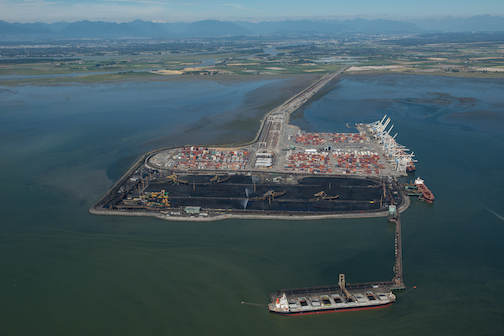
A regulatory saga that for several years has plagued a major container terminal project proposed by the Vancouver Fraser Port Authority (VFPA) is showing no signs of abating, and a final decision by the Canadian federal government has been delayed until November in light of the circumstances surrounding COVID-19.
Not only are there substantial environmental issues, but the Port of Vancouver stirred considerable controversy by blocking last year an alternative proposal from its biggest tenant, GCT Global Container Terminals. This prompted GCT, which operates the Deltaport and Vanterm terminals, to file a legal challenge with a federal court that has still not rendered its judgment.
Providing capacity for an additional 2.4 million TEUs annually by 2025 to meet anticipated demand, it would require the conversion of177 hectares of intertidal and subtidal habitat on Roberts Bank to build a new three-berth terminal, expand an existing causeway and enlarge an existing tug basin. It would be located immediately adjacent to Tsawwassen First Nation lands.
Among the findings, the report said a proposed offsetting plan for aquatic species, covering 29 hectares, would be insufficient to compensate for the reduction in productivity associated with project-induced habitat loss of 177 hectares at Roberts Bank.
The report made 71 recommendations to mitigate impacts on wetlands, aquatic species and other sectors, including the development of a marine mammal management plan and the establishment of an Indigenous advisory committee.
The report further declares: “The Project would result in a residual adverse effect on daytime and nighttime visual resources and on outdoor recreation as well as a significant cumulative effect” during both construction and operations.
Reacting to the 627-page report, the VFPA asserted that “the project and marine shipping associated with the project will not have any adverse effects to the environment that cannot be mitigated. We are eagerly awaiting the next steps in the environmental assessment, which includes a decision from the Government of Canada on whether the project can proceed.”
For his part, GCT President Doron Grosman subsequently responded that RBT2 would be a massive undertaking compared with the Deltaport 4 phased-in approach to expanding its existing facility. GCT’s budget ranges between $1 billion to $1.6 billion compared with the port authority’s cost estimate of over $3 billion for RBT2.
“British Columbia will need container port capacity that appropriately responds to the needs of exporters, consumers and the ocean shipping industry,” Grosman said. “The Deltaport berth 4 expansion is the only project that is nimble enough to do this – it is incremental, privately funded and environmentally less damaging.”
GCT officials have also argued that the VFPA’s RBT2 is based on forecasts from a decade ago that do not take into consideration significant market changes in the past few years. According to the GCT, its studies suggest that Canada’s west coast will not run out of capacity until 2030-2035 at the earliest.
GCT further contests the validity of the target set by the VFPA that no single operator should control more than two-thirds of total capacity in order to maintain a competitive market. Such a competition clause is not to be found in the Canada Marine Act, GCT maintains.
Meanwhile, in an emailed reply to questions, the Impact Assessment Agency of Canada indicated that on April 3 Jonathan Wilkinson, the federal Minister of Environment and Climate Change, extended the time limit by 90 days for the issuance of a final decision due to the COVID-19 pandemic. “If the project is authorized to proceed, the Minister will issue a Decision Statement including conditions related to the project, which would become legally binding on the proponent, no later than November 22, 2020.”
It added that the extension “will ensure that the Impact Assessment Agency of Canada has sufficient time to engage the public and consult Indigenous groups on the potential environmental assessment conditions that the proponent must comply with, should the project be authorized to proceed.”
Whichever way one looks at it, the jury remains out. Barring some sort of “diplomatic” solution between the contending visions of the GCT and the VFPA, the odds appear to be lengthening against the RBT2 project in its current form. Moreover, spiraling costs and the short-to-medium term impact of COVID-19 could soon be determining factors.

